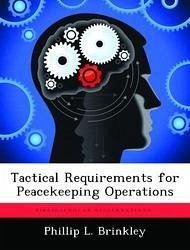In the 1980's the United States Armed Forces have been involved in two peacekeeping forces, coupled with an extremely high rotation rate of personnel, caused each successive group to experience recurring valuable lessons. This study examines training requirements, principles of command and control, and organization for a U.S. light infantry unit involved in a peacekeeping operation. The focus is on the tactical level of peacekeeping, using the Sinai Multinational Force and Observers (MFO) and the Beirut Multi-National Force (MNF) as case studies. The study determines the component parts of a peacekeeping force and analyzes the basis principles of successful peacekeeping operations. The monograph concludes that peacekeeping is a difficult military mission requiring professional personnel. The study states that peacekeeping forces must be highly trained soldiers who understand the nature and purpose of a peacekeeping mission. Finally, the study concludes that a peacekeeping force must have an internal chain of command. The most effective chain of command has one commander and one force headquarters responsible for the peacekeeping operation.








